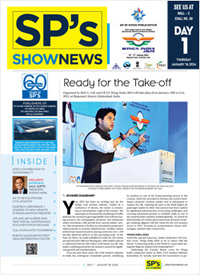- Prime Minister Narendra Modi inaugurates Aero India 2023 in Bengaluru; Releases Commemorative Stamp
- Defence Secretary meets delegations from Saudi Arabia, USA and Oman on the sidelines of Aero India 2023
- Foreign Ministers of 32 countries to attend Aero India 2023
- Embraer showcases the C-390 Millennium at Aero India 2023
Honeywell, Air India pact on runway safety

Honeywell Aerospace has signed a memorandum of understanding (MoU) with Air India enabling the airline to explore how Honeywell’s SmartRunway/ SmartLanding software upgrade can help it increase safety, improve pilot situational awareness and lower cockpit workload across its Boeing 777 fleet. The SmartRunway/SmartLanding upgrade helps mitigate runway accidents that cost the worldwide aviation industry $1 billion annually for injuries, damage, repairs and inspections.
“At Air India we are constantly looking for innovative ways to bring our passengers new levels of safety and comfort when they fly with us,” said A.K. Mathew, Executive Director of Engineering, Air India. “As we expand our network our pilots are required to fly into an ever-growing number of airports, many of which are continually changing in terms of layout. SmartRunway/ SmartLanding could make it easier for our pilots to navigate these airports regardless of visibility, and extend passenger safety even further in the process.”
Honeywell’s SmartRunway/SmartLanding system uses GPS location information and airport and object data stored in Honeywell’s enhanced ground proximity warning (EGPWS) database to determine if the aircraft is configured properly for landing, taxiing and take-off.This can dramatically reduce runway incursions, where collisions occur on the runway, or runway excursions, where aircraft accidentally leave the runway or enter a runway they are not approved for.
Under the terms of the agreement, Air India will trial SmartRunway/ SmartLanding for six months and share operational data with Honeywell to enable the two companies to examine the potential safety gains the airline would see if it deployed the software across its entire EGPWS-equipped B777 fleet. The software upgrade reduces crew workload as pilots spend less time orientating themselves, even in low visibility or at night. This is especially crucial as airlines grow their networks, train new pilots, ramp up traffic, and begin flying to new or rapidly developing airports.
Nearly 2,500 aircraft in service today already use Honeywell Smart- Runway and SmartLanding systems (including those using Honeywell’s Runway Awareness and Advisory System (RAAS) on which SmartRunway is based) to help reduce the risk of runway and landing incidents by monitoring for over 20 potential hazards. SmartLanding, which is primarily concerned with mitigating runway excursions, monitors for potentially unstable approaches, including if the aircraft is flying too high, too fast, has incorrect flap settings, long landings and accidental taxiway landings. SmartRunway mitigates runway incursions. It informs pilots which runway they are entering, confirms runway length, monitors for insufficient length remaining and can also perform flap checks to ensure proper aircraft configuration prior to take-off. Both support “heads-up” and “quiet cockpit” through aural and visual warnings.
“Air India is looking for new ways to maximize the safety of its passengers by taking advantage of the safety systems its fleet already has in place,” said Pritam Bhavnani, President, Honeywell Aerospace India. “Because Smart- Runway/SmartLanding is a software upgrade, airlines can cost-effectively add new functionality to their EGPWS with no additional weight and minimal aircraft downtime and in doing so make operations safer - even at new, unfamiliar airports and in low visibility.”
Sasi Kancharla, Customer Business Leader, Air Transport and Regional Aerospace, India, said work on GBAS system was in progress at Chennai airport and it was likely to be commissioned this year. This would avoid holding time at airports and aircraft could take curved approach for landings. This system could be highly beneficial even in small airports as it ensured ‘landing assurance’.





